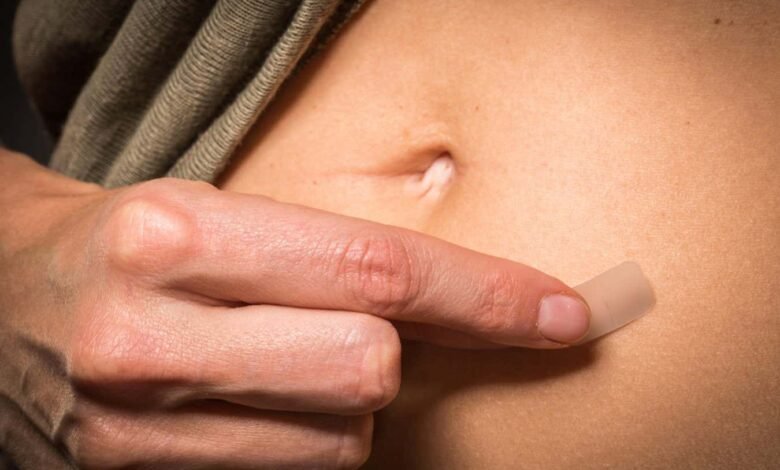Could hormone implants allow us to boost focus, endurance and libido?


What is the future for hormone patches?
Phanie – Sipa Press / Alamy Stock Photo
Fancy being in direct, hormonal control of your body and mind? By 2035, a range of options had come to the market. A pickup in the morning? A libido boost at bedtime? Or a period of immunity to pain? All became available.
The process started in 2027, when serious surface wounds and internal injuries began to be routinely treated with dressings that were themselves alive. The dressings were of a class known as engineered living materials (ELMs), which produced enzymes and antibiotics to speed up healing.
ELMs were inspired by the biofilm that sometimes forms on vinegar and is also used to make the fermented drink kombucha. Known as the “mother” layer, the biofilm is a living material, a symbiotic culture of bacteria and yeast (SCOBY). In vinegar, the SCOBY turns alcohol into acetic acid, while in kombucha, the SCOBY produces acetic acid and other compounds from sugared tea. But if you make your own synthetic SCOBY – a syn-SCOBY – with gene-edited yeast and bacteria, you can get it to produce whatever enzyme, nutrient or hormone you require. In 2021, a team at Imperial College London made programmable SCOBYs by using Baker’s yeast, which could be easily edited to produce a range of different compounds.
The first widely used syn-SCOBY was a medical material, which was kept sealed and dormant in first aid kits and in hospital surgical units. When needed, the material, which became known as a Heal Me patch, is removed and applied to a wound. Exposure to oxygen revives the yeast, which begins converting its cellulose matrix into the required compounds. These include proteolytic enzymes, which rapidly break down dead and damaged tissue, and other enzymes that relieve pain and reduce inflammation, speeding up the healing process.
After successful use in medicine, in the 2030s syn-SCOBYs were created for diverse applications, from sensing pollutants in the environment to providing essential nutrients, enzymes and hormones. Syn-SCOBYs replaced the bionic pancreas that people with type 1 diabetes used to produce insulin and control their blood sugar levels. Other varieties produced glowing proteins when a specified pollutant, metal or pathogen was detected in the environment.
Military scientists developed Fight Me patches that secreted adrenaline and testosterone, which suppressed pain and increased aggression. However, while the Heal Me patches had direct access to the bloodstream through a person’s wound, Fight Me patches had to be ingested, which meant the compounds were subjected to digestive enzymes before being absorbed. To get around this, scientists developed patches designed for implantation in the thigh or abdomen. When the soldier required the boost, they got an activation enzyme injected at the implant site. The start enzyme then set the syn-SCOBY in the patch to work secreting the desired compounds into the blood.
Customised living implants could be activated to boost focus, aggression, endurance and pain tolerance
Customised living implants could be activated when needed to boost focus, aggression, endurance and pain tolerance. Recreational syn-SCOBYs were designed to produce stimulants, psychedelics and libido enhancers.
A range of implanted patches soon became available. Feed Me secreted leptin to simulate fullness and blocked the release of ghrelin, which promotes hunger; in another variety, Sate Me, the living implant produced semaglutide drugs such as Mounjaro, Wegovy and Ozempic to remove the desire to eat or drink. Focus Me produced drugs such as modafinil and oxiracetam aimed at sharpening the mind and improving memory recall.
For recreational drug use, Trip Me secreted psychoactive compounds such as psilocybin, easily made by gene-edited yeast. Love Me suffused the user in oxytocin and serotonin, prompting feelings of love, euphoria and sexual desire. Dream Me came in two varieties, Lucid and Black Out, promoting controllable dreaming or blank deep-phase sleep, respectively.
The most exclusive and coveted implants were the Juve Me range. These produced a variety of anti-ageing compounds known as senolytics, which cleaned up ageing cells in the body, and senomorphics, such as the drugs rapamycin and metformin, which morph older cells into behaving like younger ones. Unlike most other ELMs, which had a transient lifetime in the body before being consumed, the Juve Me implant was designed to be self-sustaining. It was a symbiotic entity itself living symbiotically within a lucky human, who provided nutrients to maintain the life of the implant in return for enjoying extended life and vigour.
Hat tip to Iain M. Banks’s Culture novels for providing the inspiration for my symbiotic implants, which Banks calls “glanding”.
Rowan Hooper is New Scientist‘s podcast editor and the author of How to Spend a Trillion Dollars: The 10 global problems we can actually fix. Follow him on Bluesky @rowhoop.bsky.social
Topics:
Source link




